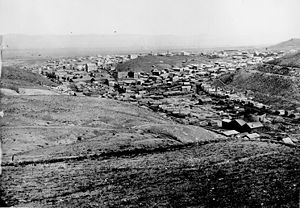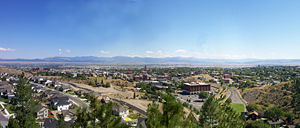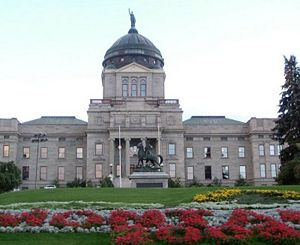Helena, Montana
| Helena, Montana | |||
|
|||
| Nickname(s): Queen City | |||
 |
|||
| Coordinates: | |||
| Country | United States | ||
|---|---|---|---|
| State | Montana | ||
| County | Lewis and Clark | ||
| Founded | October 30, 1864 | ||
| Government | |||
| - Mayor | James E. Smith | ||
| Area | |||
| - City | 14.0 sq mi (36.3 km²) | ||
| - Land | 14.0 sq mi (36.3 km²) | ||
| - Water | 0 sq mi (0 km²) | ||
| Elevation | 4,058 ft (1,237 m) | ||
| Population (2000) | |||
| - City | 25,780 | ||
| - Density | 1,840.7/sq mi (710.5/km²) | ||
| - Metro | 67,636 | ||
| Time zone | Mountain (UTC-7) | ||
| - Summer (DST) | Mountain (UTC-6) | ||
| Area code(s) | 406 | ||
| FIPS code | 30-35600 | ||
| GNIS feature ID | 0802116 | ||
| Website: www.ci.helena.mt.us | |||
Helena (IPA: /ˈhɛlɨnə/) is the capital city of the U.S. state of Montana and the county seat of Lewis and Clark County.[1] The population was 25,780 at the 2000 census, and had been estimated to rise to 27,885 by 2006.[2] The local daily newspaper is the Independent Record. The local weekly (and independent) newspaper is the Queen City News. The Helena Brewers minor league baseball team call the city home. The city is served by Helena Regional Airport.
Helena is the principal city of the Helena Micropolitan Statistical Area, which includes all of Lewis and Clark and Jefferson counties; its population was estimated at 71,119 on July 1, 2007.[3]
Contents |
History


The town was established on October 30, 1864, following the discovery of gold along Last Chance Creek by the "Four Georgians". Helena's main street is named Last Chance Gulch and follows the winding path of the original creek through the historic downtown district.
The town was originally named "Crabtown", after John Crab, one of the "Four Georgians". As other miners arrived and the town expanded, the name was changed to a more appealing title. After many suggestions, John Sommerville suggested the name of his home town, Saint Helena, Minnesota, but the pronunciation (Hel-E-na) did not suit the miners, who preferred HELL-en-a. Dropping "Saint" from the name as unnecessary, the new name Helena was adopted (defeating the name "Tomah" by only two votes).
The townsite was first surveyed in 1865 by Captain John Wood. However, most streets follow the chaotic paths of the miners, going around claims and following the winding stream. As a result, few city blocks match the ideal of 30 x 60, rather they have an irregular variety of shapes and size causing many major streets to end abruptly.

By 1888, about 50 millionaires lived in Helena, more millionaires per capita than any city in the world. About $3.6 billion (in today's dollars) of gold was taken from Last Chance Gulch over a 20-year period. The Last Chance Placer is one of the most famous placers in the western United States. Most of the production occurred before 1868. Much of the placer is now under the streets and buildings of Helena (but even as late as the 1970s, when repairs were being made to a Bank, a vein of placer gold was found under the Bank's foundation). This large concentration of wealth made for a large amount of culture, much of which still exists and is also evidenced in the varied architecture of the city and its Victorian neighborhoods.
The official symbol of Helena is a drawing of "The Guardian of the Gulch", a wooden fire watch tower built in 1886, that still stands on "Tower Hill" overlooking the historic downtown district. This fire tower replaced a series of observation buildings, the original being a flimsy lookout stand built in 1870 on the same site, built in response to a series of devastating fires: April 1869, November 1869, October 1871, August 1872 and January 1874 that swept through the early mining camp.

In 1889, railroad magnate Charles Arthur Broadwater opened his fabled Hotel Broadwater and Natatorium west of Helena. The Natatorium was home to the world's first indoor swimming pool. Damaged in the earthquake of 1935, it was closed in 1941. The many buildings on the property were demolished in 1976. Today, the Broadwater Fitness Center stands just west of the Hotel & Natatorium's original location, complete with an outdoor pool heated by natural spring water running underneath it.
In 1902, the Montana State Capitol was completed. Helena has been the capital of Montana Territory (since 1875) and the state of Montana (since 1889). A large portion of the conflict between Marcus Daly and William Andrews Clark (the Copper Kings) was over the location of the state capital.
The Civic Center and the Saint Helena Cathedral[1] are two of many unique historic buildings in Helena.
Helena High School and Capital High School are both public high schools located in the Helena School District No. 1. Being the state capital, a large number of Helenans work for the state government. When in Helena, most people visit the local walking mall (built in the early 1980s after Urban Renewal and the Model Cities Program in the early 1970s had virtually gutted the downtown district, leaving little more than unpaved parking lots and unfinished projects behind for over a decade), a three block long strip of stores following the original Last Chance Gulch. There is a stream in a concrete bed running the length of the walking mall, simulating Last Chance Creek.
The Archie Bray Foundation, an internationally-renowned ceramics center founded in 1952, is located just northwest of Helena, near Spring Meadow Lake.
Helena also has a local ski area, Great Divide Ski Area, northwest of town near the ghost town of Marysville, Montana.
Geography and climate
Helena is located at (46.595805, -112.027031)[4].
Surrounding features include the Continental Divide, Mount Helena City Park, Spring Meadow Lake State Park, Lake Helena, Helena National Forest, The Big Belt Mountains, The Gates of the Mountains Wilderness The Missouri River, Canyon Ferry Lake, and The Elkhorn Mountains.
According to the United States Census Bureau, the city has a total area of 14.0 square miles (36.3 km²), all of it land.
| Monthly Normal and Record High and Low Temperatures | ||||||||||||
| Month | Jan | Feb | Mar | Apr | May | Jun | Jul | Aug | Sep | Oct | Nov | Dec |
|---|---|---|---|---|---|---|---|---|---|---|---|---|
| Rec High °F (°C) | 72 (22.2) | 69 (20.5) | 78 (25.5) | 86 (30) | 93 (33.8) | 100 (37.7) | 105 (40.5) | 105 (40.5) | 99 (37.2) | 87 (30.5) | 75 (23.8) | 64 (17.7) |
| Norm High °F (°C) | 30.5 (-0.8) | 37.3 (2.9) | 46.8 (8.2) | 56.9 (13.8) | 65.9 (18.8) | 75 (23.8) | 83.4 (28.5) | 82.5 (28.05) | 71 (21.6) | 58.4 (14.6) | 41.5 (5.3) | 31.5 (-0.3) |
| Norm Low °F (°C) | 9.9 (-12.3) | 15.6 (-9.1) | 23.5 (-4.7) | 31.2 (-0.4) | 39.8 (4.3) | 47.5 (8.6) | 52.3 (11.3) | 50.8 (10.4) | 41.2 (5.1) | 31.2 (-0.4) | 20.3 (-6.5) | 11.3 (-11.5) |
| Rec Low °F (°C) | -42 (-41.1) | -42 (-41.1) | -30 (-34.4) | 1 (-17.2) | 17 (-8.3) | 30 (-1.1) | 36 (2.2) | 28 (-2.2) | 18 (-7.7) | -8 (-22.2) | -39 (-39.4) | -38 (-38.8) |
| Precip in. (mm) | 0.52 (13.2) | 0.38 (9.65) | 0.63 (16) | 0.91 (23.1) | 1.78 (45.2) | 1.82 (46.2) | 1.34 (34) | 1.29 (32.8) | 1.05 (26.7) | 0.66 (16.8) | 0.48 (12.2) | 0.46 (11.7) |
| Source: USTravelWeather.com [2] | ||||||||||||
Demographics
As of the census[5] of 2000, there were 25,780 people, 11,541 households, and 6,474 families residing in the city. The population density was 1,840.7 people per square mile (710.5/km²). There were 12,133 housing units at an average density of 866.3/sq mi (334.4/km²). The ethnic makeup of the city is 94.78% White, 0.23% African American, 2.10% Native American, 0.78% Asian, 0.07% Pacific Islander, 0.38% from other races, and 1.66% from two or more races. 1.67% of the population were Hispanic or Latino of any race.
There were 11,541 households out of which 27.1% had children under the age of 18 living with them, 42.5% were married couples living together, 10.4% had a female householder with no husband present, and 43.9% were non-families. 37.5% of all households were made up of individuals and 11.3% had someone living alone who was 65 years of age or older. The average household size was 2.14 and the average family size was 2.83.
In the city the population was spread out with 22.4% under the age of 18, 11.1% from 18 to 24, 26.6% from 25 to 44, 26.0% from 45 to 64, and 13.9% who were 65 years of age or older. The median age was 39 years. For every 100 females there were 91.0 males. For every 100 females age 18 and over, there were 87.6 males.
The median income for a household in the city was $34,416, and the median income for a family was $50,018. Males had a median income of $34,357 versus $25,821 for females. The per capita income for the city was $20,020. About 9.3% of families and 14.5% of the population were below the poverty line, including 16.4% of those under age 18 and 8.3% of those age 65 or over.
Higher education
Carroll College, a Roman Catholic Liberal Arts college provides education for 1,500 students. It first opened in 1909.
The University of Montana - Helena College of Technology (formerly Helena Vo-Tech), a two-year, affiliate campus of The University of Montana, provides transfer and technical education for nearly 1,000 students. It opened in 1939.
Media
Helena's Designated Market Area is 206th in size, as defined by Nielsen Media Research, and is the fifth smallest media market in the nation.
- Newspaper
- Helena Independent Record (daily, morning)
- Queen City News (weekly, independent)
- Television stations
- Radio stations – FM
- KBLL (99.5) (country)
- KZMT (101.1) (classic rock)
- KHKR (104.1) (pop hits)
- KMTX (105.3) (adult contemporary)
- Radio stations – AM
- KGR (680) (oldies)
- KMTX (950) (oldies)
- KBLL (1240) (talk)
- KCAP (1340) (talk)
Notable residents (past and present)
- Governors of Montana and other Montana state officials
- Stephen Ambrose, historian, author of Band of Brothers and Undaunted Courage
- James Presley Ball, African-American daugerreotypist, worked here for over twenty years.
- Max Baucus, Montana's United States Senior Senator
- Samuel Beall, Lieutenant Governor of Wisconsin, later practiced law here.
- Dirk Benedict, actor (A-Team)
- Brand Blanshard, philosopher, lived here for a time.
- Thomas Henry Carter, United States Senator from Montana.
- Lane Chandler, actor, graduated from high school here.
- William H. Clagett, U.S. Representative from Montana Territory
- Gary Cooper, actor
- Walter A. Coslet, figure in science fiction fandom and Bible collecting
- Margaret Craven, author, was born here.
- Charles Donnelly, later president of the Northern Pacific Railway, served as an attorney here.
- Pat Donovan, Dallas Cowboys offensive tackle, was born here.
- Rebecca Ferratti, former Playboy centerfold, was born here.
- Casey FitzSimmons, TE, Detroit Lions
- Cory Fong, Tax Commissioner of North Dakota, was raised here.
- John Gagliardi, College Football Hall of Fame coach
- Julia Hayes, glamour model, was born here.
- Rick Hill, Fmr. United States Congressman from Montana lives here
- Norman Holter, biophysicist and inventor of the Holter monitor.
- Esther Howard, actress, was born here.
- L. Ron Hubbard, author and founder of the Church of Scientology
- Christine Kaufmann Currently representes Helena in the Montana State Senate.
- Nicolette Larson, singer
- James F. Lloyd, United States Representative from California, was born here.
- Myrna Loy, actress
- Martin Maginnis, U.S. Representative from Montana Territory
- Tony Markellis, bassist and record producer, was born here.
- Thomas Francis Meagher, Irish rebel, US Civil War Brigadier General, Acting Governor of the new Territory of Montana
- Dave Meier, Major League baseball outfielder, was born here.
- Colin Meloy, lead singer of The Decemberists
- Maile Meloy, writer
- Mary Middagh, actress
- Bobby Petrino, current head football coach of the Arkansas Razorbacks
- Country Music legend Charlie Pride.
- Ernest W. Retzlaff, physiologist and author who helped develop craniosacral therapy, was born here.
- Henry H. Schwartz, later a United States Senator from Wyoming, served as Chief of the U.S. General Land Office here.
- Leo Seltzer, creator of roller derby, was born here.
- George G. Symes, later a United States Congressman from Colorado, worked as an attorney here.
- Robert L. Templeton, Olympic Gold Medalist in rugby, was born here.
- Decius Wade, the "Father of Montana Jurisprudence", practiced law here.
- Thomas J. Walsh, United States Senator from Montana, resided here.
- William F. Wheeler, U.S. Marshal, Civil War officer, Minnesota territorial Librarian and secretary to two Governors, founder of Montana Historical Society, first in the West
- John Patrick Williams, former member of the United States House of Representatives from Montana.
- Samuel Baldwin Marks Young, American general, retired to Helena.
- Alan "Scooter" Zackheim, reality show contestant on the third season of Beauty and the Geek[6].
References
- ↑ "Find a County". National Association of Counties. Retrieved on 2008-01-31.
- ↑ "Subcounty population estimates: Montana 2000-2006" (CSV). United States Census Bureau, Population Division (2007-06-28). Retrieved on 2008-05-28.
- ↑ "Annual Estimates of the Population of Metropolitan and Micropolitan Statistical Areas: April 1, 2000 to July 1, 2007 (CBSA-EST2007-01)" (CSV). 2007 Population Estimates. United States Census Bureau, Population Division (2008-03-27). Retrieved on 2008-08-31.
- ↑ "US Gazetteer files: 2000 and 1990". United States Census Bureau (2005-05-03). Retrieved on 2008-01-31.
- ↑ "American FactFinder". United States Census Bureau. Retrieved on 2008-01-31.
- ↑ "Geek of the Week", helenair.com. By Emily Donahoe - YT Staff Writer - 12/14/06. Retrieved 30 August 2008.
External links
- City of Helena web page
- Helena, Montana (Travel Montana)
- Lewis and Clark County web page
- Gulch Travel Guide for Helena, Montana
- Great Northern Carousel
- Vintage Images of Helena, Montana
- Helena, Montana is at coordinates
|
||||||||||||||||||||
|
|
|||||


